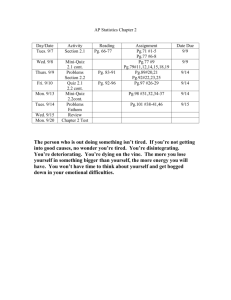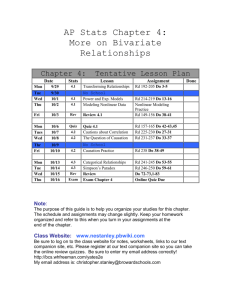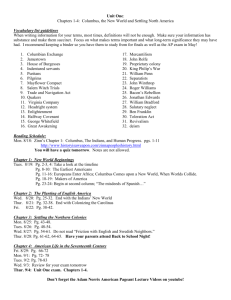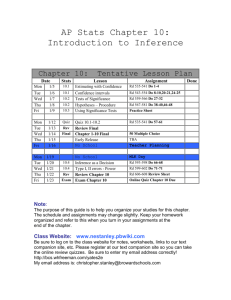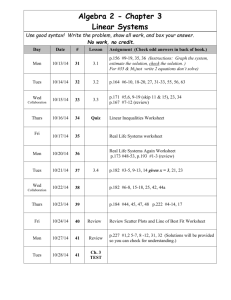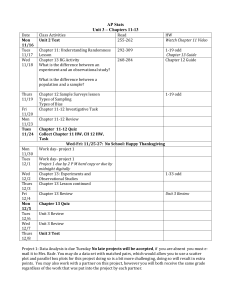Bank Management
advertisement
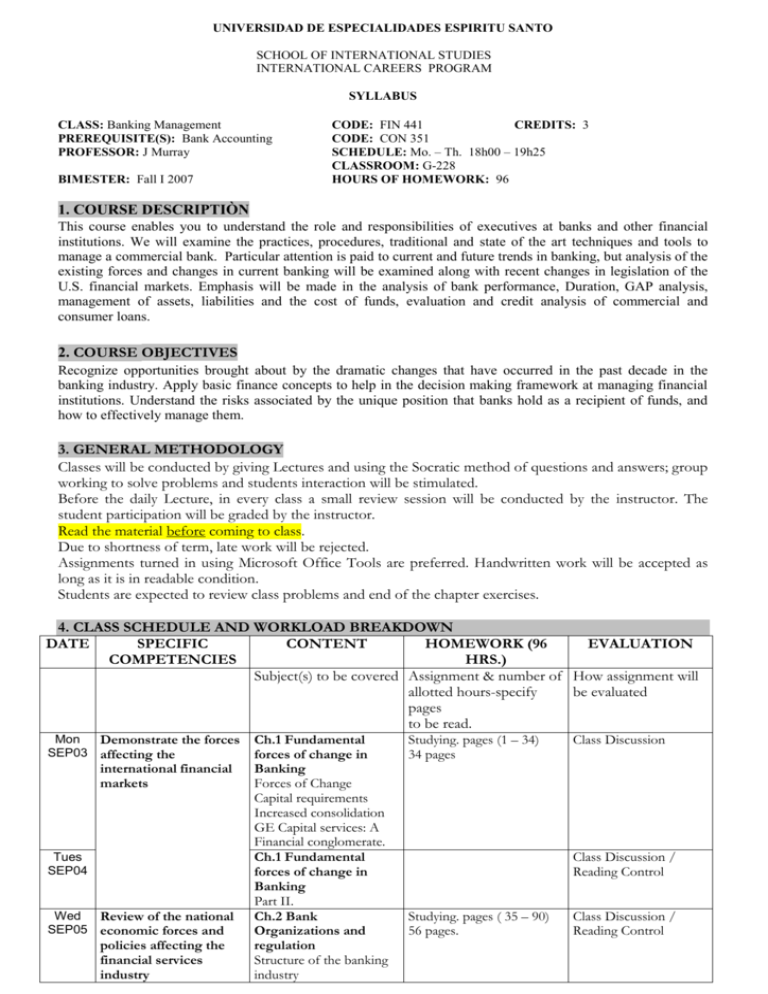
UNIVERSIDAD DE ESPECIALIDADES ESPIRITU SANTO SCHOOL OF INTERNATIONAL STUDIES INTERNATIONAL CAREERS PROGRAM SYLLABUS CLASS: Banking Management PREREQUISITE(S): Bank Accounting PROFESSOR: J Murray BIMESTER: Fall I 2007 CODE: FIN 441 CREDITS: 3 CODE: CON 351 SCHEDULE: Mo. – Th. 18h00 – 19h25 CLASSROOM: G-228 HOURS OF HOMEWORK: 96 1. COURSE DESCRIPTIÒN This course enables you to understand the role and responsibilities of executives at banks and other financial institutions. We will examine the practices, procedures, traditional and state of the art techniques and tools to manage a commercial bank. Particular attention is paid to current and future trends in banking, but analysis of the existing forces and changes in current banking will be examined along with recent changes in legislation of the U.S. financial markets. Emphasis will be made in the analysis of bank performance, Duration, GAP analysis, management of assets, liabilities and the cost of funds, evaluation and credit analysis of commercial and consumer loans. 2. COURSE OBJECTIVES Recognize opportunities brought about by the dramatic changes that have occurred in the past decade in the banking industry. Apply basic finance concepts to help in the decision making framework at managing financial institutions. Understand the risks associated by the unique position that banks hold as a recipient of funds, and how to effectively manage them. 3. GENERAL METHODOLOGY Classes will be conducted by giving Lectures and using the Socratic method of questions and answers; group working to solve problems and students interaction will be stimulated. Before the daily Lecture, in every class a small review session will be conducted by the instructor. The student participation will be graded by the instructor. Read the material before coming to class. Due to shortness of term, late work will be rejected. Assignments turned in using Microsoft Office Tools are preferred. Handwritten work will be accepted as long as it is in readable condition. Students are expected to review class problems and end of the chapter exercises. 4. CLASS SCHEDULE AND WORKLOAD BREAKDOWN DATE SPECIFIC CONTENT HOMEWORK (96 EVALUATION COMPETENCIES HRS.) Subject(s) to be covered Assignment & number of How assignment will allotted hours-specify be evaluated pages to be read. Mon Demonstrate the forces SEP03 affecting the international financial markets Tues SEP04 Wed Review of the national SEP05 economic forces and policies affecting the financial services industry Ch.1 Fundamental forces of change in Banking Forces of Change Capital requirements Increased consolidation GE Capital services: A Financial conglomerate. Ch.1 Fundamental forces of change in Banking Part II. Ch.2 Bank Organizations and regulation Structure of the banking industry Studying. pages (1 – 34) 34 pages Class Discussion Class Discussion / Reading Control Studying. pages ( 35 – 90) 56 pages. Class Discussion / Reading Control Thu SEP06 Mon Calculation of the SEP10 various methods of profitability analysis in use in the banking industry Tues SEP11 Wed SEP12 Thu Calculation of SEP13 alternative methods of enhancing bank profitability Mon SEP17 Tues SEP18 Wed Calculation of the risk SEP19 exposure of banks and the tools available to manage these risks Thu SEP20 Mon SEP24 Tues Calculation methods of Organizational form of the banking industry Bank regulation Trends in federal legislation Ch.2 Bank Organizations and regulation Part II. Ch.3 Analyzing Bank Studying. pages( 91 – 167) performance: Using the 77 pages UBPR Commercial Bank Financial Statements Relationship between Balance Sheet & Income Statement Return on equity model Bank risks & return Maximizing the market value of Bank equity CAMEL ratings Performance characteristics of different sized banks Ch.3 Analyzing Bank performance: Using the UBPR Part II. Workshop Case & Problem solving. 32 pages Ch. 4 Alternative Studying. Pages (169 – 194) models of bank 26 pages performance A critique of traditional GGAP-based performance measures Line of business profitable analysis Management of market risk Economic Value Added Ch. 4 Alternative models of bank performance Part II. Quiz Ch. 5 managing non Studying. Pages (195 – 214) interest income and 20 pages non interest expense Common financial ratios of expense control & non interest income growth Customer profitability and business mix Strategies to manage non interest expense Ch. 5 managing non interest income and non interest expense Part II. Workshop Exercises Ch.6 Pricing Fixed Class Discussion / Reading Control Class Discussion / Reading Control Class work, Problems & Discussion, Homework. Problem solving. Class Discussion / Reading Control. Class Discussion / Reading Control. Quiz Class Discussion / Reading Control. Class Discussion / Reading Control. Class work Studying, Pages (215 – 242) Class Discussion / SEP25 various investment Income Securities. 28 pages. opportunities for banks The mathematics of and other financial interest rates service companies Relationship between and option free bond prices Duration and price volatility Recent inJulations in valuation of fixed income securities Wed Ch.6 Pricing Fixed SEP26 Income Securities. Part II. Thu Review Session SEP27 Mon OCT01 Tues Use of the common OCT02 methods of managing risks Wed OCT03 Thu OCT04 Mon OCT08 Tues Determination of OCT09 investment opportunities and funding strategies Wed OCT10 MID- TERM TEST Ch. 8 Managing interest rates risk: GAP & earnings sensitivity Measuring interest rate risk with GAP Traditional static GAP analysis Earnings sensitivity analysis Income statement GAP Ch. 8 Managing interest rates risk: GAP & earnings sensitivity Part II. Ch.9 Managing interest rate risk: Duration GAP & market value of equity. Measuring interest rate risk with duration GAP Market value of equity sensitivity analysis Earnings sensitivity analysis VS. MVE sensitivity analysis Ch.9 Managing interest rate risk: Duration GAP & market value of equity. Part II. Ch.12 Managing Liabilities & the cost of Funds. The composition of bank liabilities Characteristics of small denomination liabilities Transactions accounts Calculating the net cost of transaction accounts Characteristics of large denomination liabilities Evaluating the cost of bank funds Funding costs & bank risks Ch.12 Managing Liabilities & the cost of Reading Control Class Discussion / Reading Control Class Discussion TEST Studying. Pages (289 – 321) Class Discussion / 33 pages Reading Control Class Discussion / Reading Control Studying. Pages (323 – 342) Class Discussion / 20 pages Reading Control Class Discussion / Reading Control Studying. Pages (421 – 462) Class Discussion / 42 pages. Reading Control. Homework. Class Discussion / Reading Control Thu OCT11 Mon OCT15 Tues OCT16 Wed OCT17 Thu OCT18 Mon OCT21 Tues OCT22 Funds. Part II. Calculation of the risk- Ch. 13 The effective use adjusted capital of capital required for various Risk-based capital investment strategies standards FDICIA & Bank capital standards The function of bank capital Effect of capital requirements on Bank operating policies Characteristics of external capital sources Ch. 13 The effective use of capital. Part II. Workshop. Problem solving. How to manage the Ch. 14 Liquidity bank’s obligations to its Planning & managing depositors and other cash assets. creditors The relationship between Cash & liquidity requirements Objectives of cash management Reserve balances at the federal reserve bank Meeting legal reserve requirements Managing float Managing correspondent balances Liquidity planning Traditional measures of liquidity Ch. 14 Liquidity Planning & managing cash assets. Part II Calculation of the Ch. 16 Evaluating various ratios used in commercial loan the loan analysis requests process Fundamental credit issues Evaluating credit request Loan amount & Collateral Credit analysis: An Application Ch. 16 Evaluating commercial loan requests Part II. Review Session Wed OCT23 Thu OCT24 Total of Pages 5. EVALUATION Midterm exam: 25% Final Exam: 25% FINAL TEST Class Discussion / Reading Control. Quiz. 34 pages Class Work. Practical Applications. Problems. Studying. Pages (505 – 552) Class Discussion / 48 pages Reading Control Class Discussion / Reading Control Studying. Pages (589 – 636) Class Discussion / 48 pages Reading Control Class Discussion / Reading Control Class Discussion TEST 540 pages Quizzes Project s Case studies Studying. Pages (463 – 504) Class Discussion / 42 pages Reading Control 20% 15% 10% Class Participation 5% 6. CLASSROOM POLICIES 1. Students will not be allowed after five minutes of the beginning of the class. 2. On time homework will be graded over a 100% of the grade, one day late homework over 50%, after two days homework will receive no grade. In case of absence, homework will be due the day the student returns to class. 3. All students are expected to complete readings and homework before each class so that they are prepared to present and support their ideas about each day’s assignments. Readings, class discussions, presentations, projects, lectures, and written examinations (midterm and final) will be the methods used in assigning the grade earned by each student. All material covered in readings and homework assignments (including portions not discussed in class sessions) and all material covered in class discussions, case analyses, and presentations (including material not covered in readings) can be included in the written examinations. It will not be possible to pass this course unless you read all the assigned materials. Students who keep current with reading and homework will need less time to review for the written examinations. 4. It is your responsibility to know what is in this syllabus, to know what is communicated to the class by email, to know what is in assigned readings whether or not they are discussed in class, and to know what was discussed in all class sessions whether you attended them or not. If you are absent or inattentive, it is your responsibility to ask a classmate what you missed before attending the next class meeting. If you do not understand something, it is your responsibility to ask for clarification. 5. This course follows the UEES attendance policy; therefore, it is possible to pass the course with a maximum of six absences but the seventh absence results in failure of the course regardless of your earned grade to date. Partial absences, including late arrivals, early departures, and leaving during class will count toward the six permitted absences. 6. Please do not talk in class when it is not your turn to speak. I will automatically consider this inattentiveness and a disruption to the class. If you must communicate with another person during class related to the topic of class discussion or due to a rare emergency, please write the person a note to avoid making noise. 7. Students are expected to respect the thoughts, ideas, opinions, and contributions of others and to be actively involved in all classes. Students should express disagreement respectfully. 8. Cell phones must be silent during all class sessions. Cell phone use during class will result in immediate expulsion from the classroom for the balance of the day. During examinations, cell phones always must be silent and out of view of all students. 9. If an examination or presentation must be missed, the student must make arrangements promptly for substitute work. The professor reserves the right not to offer a substitute. A substitute must be arranged by mutual agreement between the professor and the student and must be completed no later than the end of the last class period. Because substitute work detracts from normal class activities and/or creates unnecessary extra work for the professor, substitute work will be more demanding and/or will offer reduced points compared to work completed according to the class schedule. A substitute examination will never be the same as the scheduled examination. 10. Academic dishonesty is unethical, unfair to others, and robs you of valuable learning opportunities. Discovery of academic dishonesty will result in a zero for the graded activity and can result in your failing the course and being reported to the UEES administration. Examples of academic dishonesty include but are not limited to using or attempting to use another person’s work for assignments, projects, or examinations; permitting another person to use your work as their own; failing to credit quotes or ideas taken from others (Internet, publications, speeches, etc.); seeking help through a cell phone during a class or examination; using all or part of your own homework, paper, etc., for another class in this class without permission and acknowledgement; etc. If you are not sure whether something is academic dishonesty, it is your responsibility to ask the professor. 11. Food or beverage in the classroom must not bother anyone in the class in any way (noise, smell, etc.) or create any mess that you do not clean up yourself. 12. This course is to benefit the students, not the professor. If you are not getting what you need and want from this course, please let the professor know improvements you would like. NOTE: This syllabus is subject to revision and does not represent a contact between the student and the instructor, or between the student and the University. The instructor and/or the University reserve the right to make any reasonable changes. By attending this class you have agreed to the conditions and regulations stated in this syllabus. 7. BIBLIOGRAPHY: COURSEBOOK: Rose, Peter S, 2002, Commercial Bank Management, Fifth Edition, McGraw-Hill COMPLEMENTARY TEXT: Additional Handouts will be provided by the Professor 8. Additional Requirements: A Financial calculator is required in every class. Familiarity with MS Excel recommended. 9. TEACHER INFORMATION NAME: John F. Murray, CPA DEGREES: B.S. Industrial Management, Purdue University; MBA, University of Chicago; Certified Public Accountant (CPA) EMAIL: jmurray6834@yahoo.com PHONE: 09 594 3169

